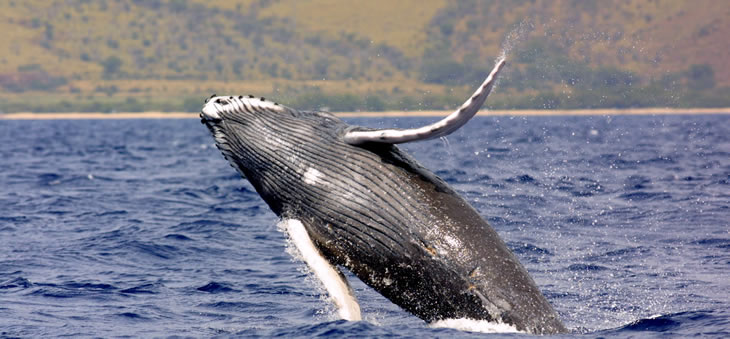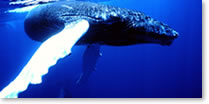Alaska Whales
Alaska has whales all throughout the state
There are eight species of whales that frequent the cold and icy waters of Alaska. The Beluga, Humpback, Grey, Orca, Bowhead, Blue, Right, and Minke whales. Like all mammals, Alaska whales breathe air into lungs, are warm-blooded, breast-feed their young, and have some (although very little) hair. The Alaska whales ancestors lived on land, and their adaptions to a fully aquatic life are quite striking. The body is fusiform, resembling the streamlined form of a fish. The forelimbs, also called flippers, are paddle-shaped. The end of the tail holds the fluke, or tail fins, which provide propulsion by vertical movement. Although Alaska whales generally do not possess hind limbs, some whales (such as sperm whales and baleen whales) sometimes have rudimentary hind limbs; some even with feet and digits. Most species of whale bear a fin on their backs known as a dorsal fin.

Alaska Whales are Cetaceans:
From the NOAA Mammal website:
Cetaceans are relatively large, generally characterized by streamlined bodies that glide easily through the marine environment. Approximately 78 species of whales, dolphins, and porpoises are included in the Order Cetacea.
Cetaceans are broken into two Suborders, or main groups:
1.Mysticeti (baleen whales)
2.Odontoceti (toothed whales)
There are 11 species of baleen whales and 67 species of toothed whales.
Status of Cetacean Species
All cetaceans are protected under the Marine Mammal Protection Act (MMPA); some may be designated as “depleted” under the MMPA. Endangered and threatened cetaceans are further protected under the Endangered Species Act (ESA).
Alaska Whales Breathing:
Alaska whales breathe through blowholes, located on the top of the head so the animal can remain submerged. Baleen whales have two; toothed whales have one. The shapes of whales’ spouts when exhaling after a dive, when seen from the right angle, differ between species. Whales have a unique respiratory system that lets them stay underwater for long periods of time without taking in oxygen. Some whales, such as the Sperm Whale, can stay underwater for up to two hours holding a single breath. The Blue Whale is the largest known animal that has ever lived, at up to 93 feet long and 180 tons.
Whale Skin:
Beneath the skin lies a layer of fat, the blubber. It serves as an energy reservoir and also as insulation. Whales have a four-chambered heart. The neck vertebrae are fused in most whales, which provides stability during swimming at the expense of flexibility. Their skin has evolved hydrophilic properties. Its surface is covered with microscopic pores surrounded by nanoridges. Between these ridges there is a rubber-like gel which is excreted from the gaps between the skin cells. This gel contains enzymes that attacks microbes, and the edge of the ridges makes it hard for smaller organisms to get attached.
Eight species of Alaska Whales
Beluga Whale:
Beluga whales are not born white. It takes about 6 years until they gradually turn white. Belugas are one of the three Alaska whales that spend all their lives in arctic waters. Beluga are special among all whales because they can turn their heads. Maybe this is so that they can communicate with each other better! Beluga are very social and make a wide variety of sounds.
Beluga Whales near Anchorage Video:
Humpback Whale:
Graceful and magnificent, humpback whales inspire awe in young and old alike. These marine mammals travel great distances to take advantage of the best breeding grounds and feeding spots. North
Pacific humpbacks, for example, mate and give birth in Hawaii and then travel to Alaska each summer to feed.
Gray Whale:
Whalers used to call them “devilfish” because of the fierce defense they put up when hunted. In its lifetime, the average gray whale commutes over 400,000 miles – the equivalent of a trip to the moon and back. Each year, gray whales go back and forth between their feeding grounds in the Arctic to breeding grounds off the coast of Baja California. They spend six months of the year just traveling!
Orca – Killer Whale:
Killer whales are social animals that live in stable family-related groups. Killer whales display a high level of care for their offspring. In addition to the mothers, various pod members (mainly adolescent females) perform most of the care for the calves. As with most mammals, killer whales are very protective of their young. Killer whales are often compared to wolves because both species are top predators, maintain complex social relationships, and hunt cooperatively.
Bowhead Whale:
Bowhead whales were hunted by commercial whalers for over four centuries, beginning in the North Atlantic in the 1500s and ending in the North Pacific by the mid-1900s. Bowhead whales are capable of breaking through sea ice at least 8 inches thick; some Eskimo hunters have reported whales surfacing through 2 feet of thick ice.
Blue Whale:
Everything about the blue whale is enormous. It is the largest animal on earth, ever. A big blue whale can be 100 feet long and weigh up to 150 tons. That’s as large as a Boeing jet. Its heart is as large as a small car. Fifty people could stand on its tongue. Its spout shoots up at least 30 feet when it surfaces for air.
Right Whale:
Right whales prefer coastlines and sometimes large bays, but may spend a lot of time on the open sea. The Northern right whale populations are considered to be close to extinction. Right whales are baleen whales, they filter their food through their long baleen plates. Right whales open their great mouths and graze along the surface of the water. Right whales mostly eat small crustaceans including copepods and small shrimp-like animals called euphausiids.
Minke Whale:
The minke is the smallest of the baleen (filter-feeding) whales and is found throughout the world’s oceans, from the Arctic to the Antarctic. This is an inquistive cetacean and will frequently approach and linger around ships. The natural life span of minke whales is about fifty years









I am going on a cruise from Seattle to Alaska on September 10th this year (2015) I would like to know if I will see any whales and if so whereabouts will they be
Maybe. They could be in the waters just outside of Seattle and all the way to Alaska.
How likely is my chances of seeing a whale the beginning July?
Very good. Especially in Glacier Bay and pretty much anywhere in Southeast Alaska.
I just got back from Alaska we saw a lot of different whales, pod of orca’s, humpback, and a sperm whale. I’m so glad I listened to our people the best time to go second week in May, we did a cruise.